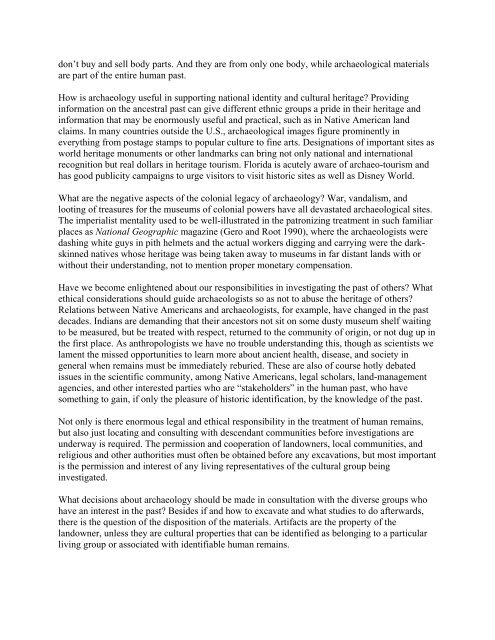INTRODUCTION TO ARCHAEOLOGY Nancy White - Touro Institute
INTRODUCTION TO ARCHAEOLOGY Nancy White - Touro Institute
INTRODUCTION TO ARCHAEOLOGY Nancy White - Touro Institute
Create successful ePaper yourself
Turn your PDF publications into a flip-book with our unique Google optimized e-Paper software.
don’t buy and sell body parts. And they are from only one body, while archaeological materials<br />
are part of the entire human past.<br />
How is archaeology useful in supporting national identity and cultural heritage? Providing<br />
information on the ancestral past can give different ethnic groups a pride in their heritage and<br />
information that may be enormously useful and practical, such as in Native American land<br />
claims. In many countries outside the U.S., archaeological images figure prominently in<br />
everything from postage stamps to popular culture to fine arts. Designations of important sites as<br />
world heritage monuments or other landmarks can bring not only national and international<br />
recognition but real dollars in heritage tourism. Florida is acutely aware of archaeo-tourism and<br />
has good publicity campaigns to urge visitors to visit historic sites as well as Disney World.<br />
What are the negative aspects of the colonial legacy of archaeology? War, vandalism, and<br />
looting of treasures for the museums of colonial powers have all devastated archaeological sites.<br />
The imperialist mentality used to be well-illustrated in the patronizing treatment in such familiar<br />
places as National Geographic magazine (Gero and Root 1990), where the archaeologists were<br />
dashing white guys in pith helmets and the actual workers digging and carrying were the darkskinned<br />
natives whose heritage was being taken away to museums in far distant lands with or<br />
without their understanding, not to mention proper monetary compensation.<br />
Have we become enlightened about our responsibilities in investigating the past of others? What<br />
ethical considerations should guide archaeologists so as not to abuse the heritage of others?<br />
Relations between Native Americans and archaeologists, for example, have changed in the past<br />
decades. Indians are demanding that their ancestors not sit on some dusty museum shelf waiting<br />
to be measured, but be treated with respect, returned to the community of origin, or not dug up in<br />
the first place. As anthropologists we have no trouble understanding this, though as scientists we<br />
lament the missed opportunities to learn more about ancient health, disease, and society in<br />
general when remains must be immediately reburied. These are also of course hotly debated<br />
issues in the scientific community, among Native Americans, legal scholars, land-management<br />
agencies, and other interested parties who are “stakeholders” in the human past, who have<br />
something to gain, if only the pleasure of historic identification, by the knowledge of the past.<br />
Not only is there enormous legal and ethical responsibility in the treatment of human remains,<br />
but also just locating and consulting with descendant communities before investigations are<br />
underway is required. The permission and cooperation of landowners, local communities, and<br />
religious and other authorities must often be obtained before any excavations, but most important<br />
is the permission and interest of any living representatives of the cultural group being<br />
investigated.<br />
What decisions about archaeology should be made in consultation with the diverse groups who<br />
have an interest in the past? Besides if and how to excavate and what studies to do afterwards,<br />
there is the question of the disposition of the materials. Artifacts are the property of the<br />
landowner, unless they are cultural properties that can be identified as belonging to a particular<br />
living group or associated with identifiable human remains.
















